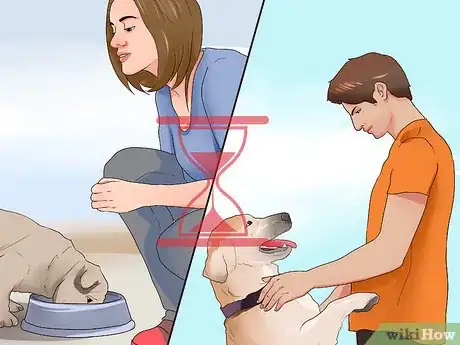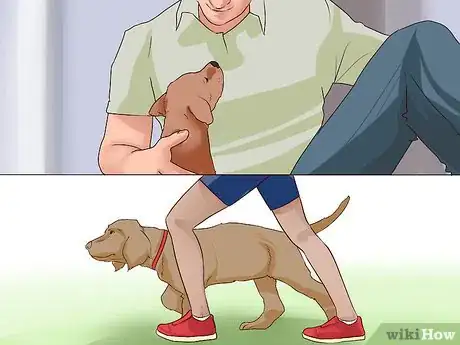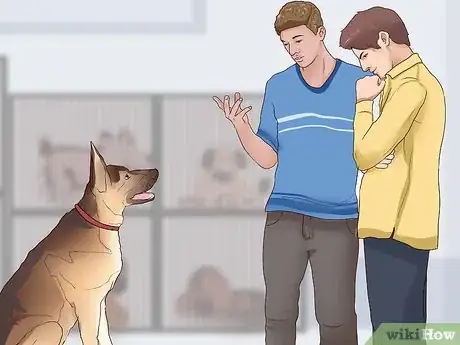This article was co-authored by Deanne Pawlisch, CVT, MA. Deanne Pawlisch is a Certified Veterinary Technician, who does corporate training for veterinary practices and has taught at the NAVTA-approved Veterinary Assistant Program at the Harper College in Illinois and in 2011 was elected to the board of the Veterinary Emergency and Critical Care Foundation. Deanne has been a Board Member of the Veterinary Emergency and Critical Care Foundation in San Antonio, Texas since 2011. She holds a BS in Anthropology from Loyola University and an MA in Anthropology from Northern Illinois University.
There are 12 references cited in this article, which can be found at the bottom of the page.
This article has been viewed 38,347 times.
Dogs can bring happiness and companionship into a loving home, but they are also a major, long-term responsibility. It is important to thoroughly consider whether you truly want and can handle having a dog before you adopt. Consider the financial commitment and how much time you will have to spend with the dog over its life, along with other factors such as what breed is right for your home. By taking a critical eye to your life and your expectations of your new pet, you can decide if getting a dog is the right choice for you.
Steps
Evaluating Your Life
-
1Consider your home space. A dog is going to need a safe indoor space that has room for it to live happily. Additionally, it should have access to an outdoor space such as a yard or park nearby for relief as well as for exercise and play.[1]
- If you rent your home, make sure your landlord is ok with you having a dog before you adopt. Get a rider to your lease saying it’s ok for you to have a pet, if possible, and be prepared to pay a pet deposit.
- Think about the type of breed you want. Different breeds require different spaces. Generally speaking, larger dogs will need more space overall, and sporting or hunting breeds tend to like consistent access to outdoor spaces.
- Make sure the dog has an indoor space. Chaining your dog outdoors not only exposes them to a number of environmental dangers, but is not humane and many townships and states have laws against doing this. If you are considering a dog that would spend most of its time outdoors, still make sure you have a designated indoor space for when you are not home, for the nights, and for inclement weather.
-
2Think about your schedule. Consider what is most important to you right now. Do you work long hours? Do you like spending most nights out? Are you planning on making any major life changes such as moving or expanding your family any time soon.[2]
- Consider whether your life has room in for the needs and responsibilities that come with a dog.
- Think about whether you want a dog for occasional companionship or if you are looking for a lifelong companion animal. If you are only looking for occasional companionship, a dog might not be right for you.
Advertisement -
3Work on a budget. Along with lifelong costs, getting a dog comes with some initial overhead. You will either have to pay an adoption fee or the often expensive breeder fee to take the dog home. In addition, you will also have to pay for initial supplies for the dog such as food, dishes, a bed, a crate, toys, vaccines, spaying or neutering, obedience training, and more.
- The overall cost of owning a dog in the first year depends greatly on the dog and its specific needs, but often ranges well over $1,000.[3]
- If you do not have the money to handle the initial cost of adoption at the time you want to adopt, consider postponing getting a pet until you can fully afford it.
-
4Talk to members of your household. Before you bring a dog into your home, talk to the other members of your household to make sure they are prepared for the new pet. Allow them the chance to raise any concerns and have an open, honest discussion about the subject.
- If you have roommates, discuss what their responsibilities would be with the dog. Would they help care for it, or would you be the primary owner and caregiver?
- Work out responsibilities with your family. Would your children help take care of the dog? Who would fulfill what duties when it comes to caring for the pet?
-
5Think about the timing. Finally, think about when it will actually be best to get your dog. For instance, you may not want to deal with house training a new puppy in the winter. Likewise, if you are currently going through some major changes in life, like moving or getting married, it is probably best to wait to get your dog until after things are settled and you are not so busy.
Thinking About the Responsibilities
-
1Consider the responsibilities. A dog requires daily attention, regular affection, and regular care. Consider whether you have the time and will to properly take care of a dog, including daily walks, feeding, and playtime as well as providing regular vet checks and other care as necessary.[4]
- If you away from home for long hours, or if purchasing pet care such as food and vet checks would be a substantial burden, you may not be able to properly care for a dog at this moment.
- If you have any doubts about whether you can handle the responsibilities of having a dog, put off adoption until you able to better assess your needs and make sure you can care for a pet.
-
2Study lifelong needs. Think about the type of dog you want and whether you can handle problems often associated with that breed. Small dogs, for example, are often prone to problems like arthritis, which can lead to mobility challenges and increased vet bills as the dog ages.[5]
- Look online, read breed guides, and talk to other dog owners about the lifelong needs of their pet to get a better idea of what type of commitment you could be making.
- Consider whether you will be able to afford products such as specialty foods, regular vet checks, and medication as your dog ages.
- Further remember that most dogs will live 10 to 13 years. Consider whether you have a long term life plan that will allow you to keep a dog for one to two decades.[6]
-
3Consider physical needs. All dogs need some physical exercise. Consider whether you are able to give this, and to what degree. The level of activity to which you can commit helps you decide not only if you want a dog but what type of dog is right for you.[7]
- Sporting, herding, and working breeds will often require more exercise, and will need long walks multiple times a day.
- Smaller breeds such as toy dogs and terriers will still need frequent exercise, but can generally be taken for shorter walks.
- Regardless of breed, expect to walk the dog at least twice a day every day. If you cannot commit to that, a dog may not be right for you.[8]
Choosing the Type of Dog for You
-
1Think about adoption. If you are considering getting a dog, think about whether you want to buy a dog from a breeder or adopt. Adopting from an animal shelter provides a dog with a second chance at finding a loving, caring home.[9]
- Contact local pet shelters to see what dogs they have available and to arrange a time for you to come down and meet with potential pets.
- If you choose to purchase a pet from a breeder, check their client testimony and with breeding associations to ensure they are an ethical, reputable breeder committed to breeding healthy dogs in nurturing conditions.
-
2Find a breed. Think about what type of dog best fits your activity level and lifestyle. Consider factors such as how much room you have to give, whether your home life is more quiet or social, and how physically active you are on a regular basis. Consider asking a veterinarian or vet technician what breed might suit you best.[10]
- Use breed guides, online breed specific resources, and knowledgeable workers at your local animal shelter or pet store to help you figure out what breeds have personality traits that coincide with your lifestyle.
- If you’re considering adoption, try not to limit yourself to just one breed, as shelters may not have a dog of that breed (unless there is a breed specific rescue in your area). Instead, pick a few breeds that may work for you. Alternatively, see if there is a specific breed rescue in your area.
- Do not think that you need a dog that is purebred or a single breed. Mutts are often healthy and lovable dogs with their own, distinct personalities.
-
3Pick a dog for your lifestyle. Think about your lifestyle and consider what type of dog would best fit your day to day life. Do you want a dog that is high or low energy? Are you looking for a dog for security or companionship?
- Breeds such as bulldogs, spaniels (though the Brittany and Springer spaniels are high energy dogs), havanese, greyhounds, and schipperkes are all dogs that require mental challenge more than physical challenge, and so are good for small spaces such as apartments as well as lower energy homes.[11]
- Border collies, shepherds, huskies, and Rhodesian ridgebacks are all high energy dogs that can run for miles if you are looking for a workout buddy.[12]
- If you’re looking for a companion, try breeds like retrievers, schnauzers, and poodles, while dogs like shepherds provide good security along with companionship.[13]
-
4Meet with some adoptable dogs. One of the best ways for you to get a feel for a dog’s personality is to meet with it. Talk to your local shelter or, if you do not have a local shelter, breeder about setting up a time to come visit available dogs and see if one is the right fit for you.
- Know that dogs in shelters or large, changing groups may be shy or more rowdy than they will be at home. These dogs are frequently approached by strangers have their groups broken apart, so develop their own means of coping with that stress.
- Plan to take 20 to 30 minutes with each dog you want to meet. This gives you time to get past initial curiosity and start truly interacting with the dog.
- Ask the shelter workers which ones are their favorites and why to help get a sense of what the dog is like with people around whom it is comfortable.
Warnings
- Beware of puppy mills, which are often abusive and known for their brutal conditions. Usually these dogs are sold into pet shops.⧼thumbs_response⧽
- Do not buy on impulse. Oftentimes, people don't realize the work involved in caring for a dog. But they get it anyway and end up giving it away or dumping it at a shelter. This is very cruel and traumatizing for the dog. So please make sure you are fully ready to buy an animal!⧼thumbs_response⧽
- Do not forget that a dog is a living creature with emotions and needs. You will need to satisfy them to keep it happy.⧼thumbs_response⧽
References
- ↑ https://www.akc.org/expert-advice/puppy-informations/are-you-ready-for-a-dog/
- ↑ http://www.vetstreet.com/our-pet-experts/7-signs-you-shouldnt-get-a-dog
- ↑ https://www.moneyunder30.com/the-true-cost-of-pet-ownership
- ↑ https://thedoggerel.wordpress.com/2011/07/21/6-types-of-people-who-shouldnt-get-dogs/
- ↑ http://www.vetstreet.com/our-pet-experts/7-signs-youre-ready-to-get-a-dog
- ↑ http://www.petmd.com/dog/wellness/evr_dg_how_long_do_dogs_live
- ↑ http://thebark.com/content/how-much-exercise-does-your-dog-need
- ↑ http://thebark.com/content/how-much-exercise-does-your-dog-need
- ↑ http://www.humanesociety.org/issues/adopt/tips/top_reasons_adopt.html?referrer=https://www.google.com/
About This Article
To decide if you want a dog, start by considering your current life situation and home space. Because dogs require considerable attention and care, you might not have time to properly care for one if you're rarely home. In order to determine what kind of dog will be best for you, consider your activity level and lifestyle. For example, if you don't have much spare time, energy, and space, you may not want a herding dog that will need to be taken on long walks, multiple times a day. You should also create a budget to make sure you can afford the cost of owning a dog, which often exceeds $1,000 in the first year due to expenses like adoption fees and vaccinations. For more advice from our Veterinary co-author, like how to meet adoptable dogs, keep reading!




































































